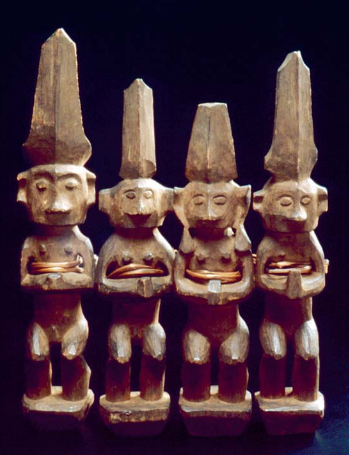What was your favorite object from today’s visit to the Asian Civilizations Museum?
My favourite object from the museum was the Nias’ adu zatua shown here –
 (photo courtesy of the Asian Civilisation Museum)
(photo courtesy of the Asian Civilisation Museum)
The adu zatua is a small free-standing wooden statuette, with adu meaning “carving” and zatua meaning “elder”. They were anthropomorphic and traditionally created so that the spirits of one’s ancestors could live in these carvings. They often had to be placated with offerings, usually eggshells or pig offal (specifically the liver or heart), during major events like births, weddings or deaths. It was believed that the goddess Silewe Nazarata (moon goddess and personification of all living things) introduced this tradition of making wooden idols to mark certain important events and since ancestral worship was at the heart of Nias beliefs, this tradition carried on till the 1920s, when the Dutch missionaries outlawed the carving of idols. The Nias people believed that it was crucial to establish a good relationship with one’s deceased relatives so that one could live a good life and prevent the experience of misfortune.
What struck me about this object was my family’s history with such carvings. I come from a Catholic household where idolatry is considered blasphemous and ethnic superstition (i.e Chinese beliefs, like no sweeping the house during all 15 days of Chinese New Year or ) is observed purely to ‘be better safe than sorry’. So we never really believed in the power of magical objects.
One year, my parents went to Bali and brought back a small wooden carving that I believe was an adu zatua as it resembled a small person with a tall headdress. To them, it was only a souvenir, evidence that they had fallen into a tourist trap and come away wallets lighter. Not understanding the spiritual origin and implications of it, my mother placed it in our house and not too long later, strange things started happening in our home. My brother and mother both reported hearing someone calling their names in the house even though no one was around, there was a change in the atmosphere of our home, and the statuette often fell down from its place in our staircase display enclave on its own.
My parents eventually put two and two together and quickly got rid of the carving (I think they threw it away outside the house, so the spirits didn’t remain in our home). This experience reminded me that in our admiring of objects that are so rich in cultural history like the adu zatua, we tend to forget that these are objects of power. It might be superstitious to say so, but these items should be handled with respect and an understanding of their history, as well as of the cultural or religious practices surrounding it. The last thing one would want would be to incur the wrath some otherworldly being, skeptic or not.
